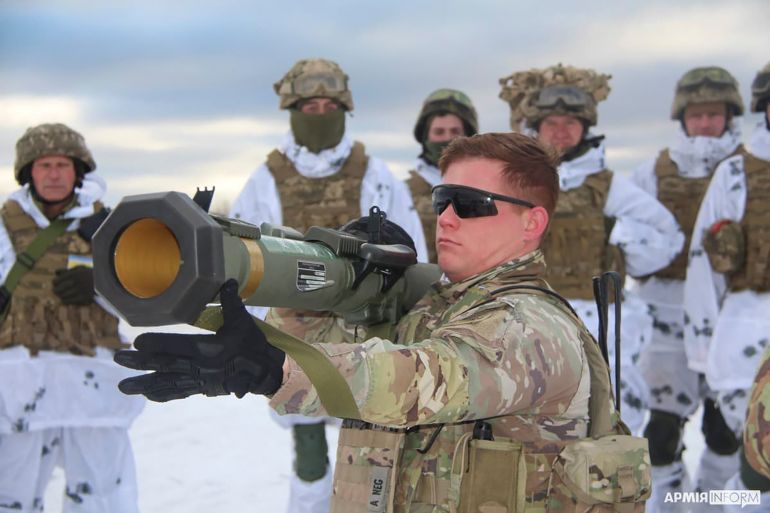Ukraine crisis: US to deploy more troops to Eastern Europe
Pentagon stresses US forces are not going to Ukraine, but to bolster the security of NATO nations in Eastern Europe.

The United States is sending 2,000 additional soldiers to Europe and repositioning another 1,000 from Germany to Romania to ensure the “robust defence” of European NATO members, the Pentagon has said, amid the ongoing impasse between Russia and Ukraine.
US Department of Defense spokesman John Kirby told reporters on Wednesday that the troop deployment would take place in the coming days. He said it is separate from, and in addition to, the 8,500 soldiers that the Pentagon put on heightened alert last week.
Keep reading
list of 3 itemsPutin says US is using Ukraine as a ‘tool’ to contain Russia
Germany bans German-language Russian state broadcaster RT
Kirby stressed, however, that the US forces are not going to be deployed to Ukraine, which is not a NATO member.
“These movements are unmistakable signals to the world that we stand ready to reassure our NATO allies and deter and defend against any aggression,” he said.
The White House announced Wednesday that 1,700 soldiers would deploy from Fort Bragg in the US state of North Carolina to Poland and another 300 would be sent from the base to Germany.
The Russian military has been amassing troops near the country’s border with Ukraine, sparking a diplomatic crisis and heightening US and European fears that Moscow may be preparing for an imminent invasion of its neighbour.
Russia has denied it is planning to invade, but has vehemently opposed Ukraine’s efforts to join NATO. Moscow also wants security guarantees that the US-led alliance will stop its expansion into former Soviet republics, but Washington and NATO have rejected the demand as a “non-starter”.
Pentagon confirms proposal to Russia
On Wednesday, Kirby confirmed media reports that Washington offered to allow Moscow to confirm there are no Tomahawk cruise missiles at bases in Romania and Poland – on the condition that Russia reciprocates with its own “transparency measures”.
Spanish newspaper El Pais had published US documents outlining the proposals earlier in the day.
Kirby said while the US did not make the documents public, they illustrate that Washington is serious about resolving the crisis diplomatically.
“If Russia actually wants to negotiate a solution as it claims it does, this document certainly makes clear that there is a path forward to do so,” he said.
The US delivered written responses addressing Russia’s security concerns last week, but senior Russian officials have responded with wariness to Washington’s position.
“It is already clear that fundamental Russian concerns ended up being ignored,” Russian President Vladimir Putin said on Tuesday – his first comments on the ongoing crisis in more than a month.
Putin said the Kremlin was studying a response from the US and NATO but said the replies had been far from adequate. He accused the US of using Ukraine as a “tool” in its efforts to contain Russia, but said it was still possible to find a solution to end the crisis.
“I hope that we will eventually find a solution, although we realise that it’s not going to be easy,” Putin said.
Kirby also told reporters on Wednesday that war can be avoided. “The Department of Defense will continue to support diplomatic efforts led by the White House and the State Department to press for a resolution. We do not believe conflict is inevitable,” he said.
Russia responds
Moscow denounced the US move later on Wednesday, calling it “destructive”.
The US deployments are “destructive steps, which increase military tension and reduce scope for political decision,” Russian Deputy Foreign Minister Alexander Grushko told the Interfax news agency.
But US State Department spokesperson Ned Price rejected Moscow’s assertion that Washington is escalating tensions by sending additional troops to Europe, accusing Russia of attempting to turn “reality upside down”.
“These are not permanent moves; they are precisely in response to the current security environment in light of this increasingly threatening behaviour by the Russian Federation,” Price told reporters on Wednesday.
US President Joe Biden said the decision was “totally consistent” with what he had told Putin. “As long as he is acting aggressively we’re going to make sure we can reassure our NATO allies and Eastern Europe that we’re there,” Biden told a CNN reporter.
NATO welcomes US decision
NATO Secretary-General Jens Stoltenberg welcomed the US decision to send additional troops to Europe.
“This is a powerful signal of US commitment, and comes on top of other recent US contributions to our shared security,” Stoltenberg said in a statement on Wednesday.
US Republican Senator Lindsey Graham also lauded the troop deployment.
“I completely support the Biden Administration’s decision to send more US troops to bolster NATO allies in the face of Russian aggression,” Graham wrote on Twitter. “It is imperative that NATO meet the moment and that we stand firmly against Putin’s efforts to divide the alliance.”
But other Republicans who favour a more reserved foreign policy denounced Biden’s move.
“I am strongly opposed to President Biden’s decision to send American troops to Eastern Europe to defend countries that should defend themselves, potentially involving us in another conflict after just ending a 20-year war,” Republican Senator Mike Braun said, referring to the Afghanistan conflict.
Al Jazeera correspondent Kimberly Halkett underscored many Americans’ “fatigue” of wars.
“In the United States, there certainly is a lot of fatigue surrounding conflict in general, particularly given the fact that there was that messy withdrawal of US troops from Afghanistan just a few months back… the United States is just as a population tired after a generation of war,” Halkett said.